Beyond the farms and forests of Northern New Jersey lies a fantastical outdoor art museum. Here, the ordinary is transformed into the extraordinary, and everyday objects are given a new life. Old bowling balls line the driveway while wooden crutches stand to form a fence. Ceramic gravy boats serve as indoor waterfalls and wine corks are repurposed as wall decor. Peculiar and thought-provoking, these pieces of artwork can be found nowhere but Luna Parc in Sandyston Township.
Luna Parc is the private home and studio of madcap New Jersey artist, Ricky Boscarino. In 1982, the young artist graduated from the Rhode Island School of Design eager to create. When he first bought the property in 1989, the then 28-year-old craftsman had no intention of turning it into the spectacle it is today. But as his passion for art and architecture grew, so did Luna Parc. For the last 31 years, Ricky has continued to renovate the property, regularly redesigning the house and adding to the fixtures outside. The original 600-square-foot cottage has evolved into a mansion nearly 10 times its size accompanied by an abundance of outdoor sculptures.
In the early 2000s, Ricky decided to open Luna Parc to the public on select weekends. Every year, thousands of guests travel from far and wide to marvel at Ricky’s zany paintings, intricate mosaics, and eclectic sculptures. Inside his extravagant manor, visitors can explore most of the elaborate rooms filled with artwork and artifacts. Unfortunately, the COVID-19 pandemic temporarily closed the park, but tours of the grounds will hopefully resume in the coming months. Recently, on a rainy May afternoon, I sat down with the eccentric artist in his grand ballroom to ask him a few questions about the property.
1. With so many beautiful, artsy communities across the country, why did you decide to move back to New Jersey after college?
After graduating from RISD, I lived in New Haven, Connecticut for a couple of years where I did a jewelry apprenticeship. Then I went to get my master’s at NYU film school. It was really fun, but I just didn’t think going into the film industry was something that I really wanted to do. So I just went for one year and I loved it. After that, I came back to New Jersey to start a jewelry business with this woman who I had apprenticed for when I was in high school. We became partners and that’s kind of why I came back to this area.
2. Having been born in Paterson and raised in Piscataway, what drew you north to Sandyston Township?
I was always familiar with North Jersey because I went to summer camp up here at Stokes Forest. As a kid, Sussex County seemed so far away; it seemed like you were going to Alaska or something. I have lots of space up here, so I can spread out. I was able to build this house which I would have never, ever been able to do anywhere else. Anywhere else in New Jersey would never allow such a spectacle to be built. In Sandyston, we don’t have any particular design codes or architectural codes. Plenty of the standard state building codes, but basically I could build anything I wanted and I did!
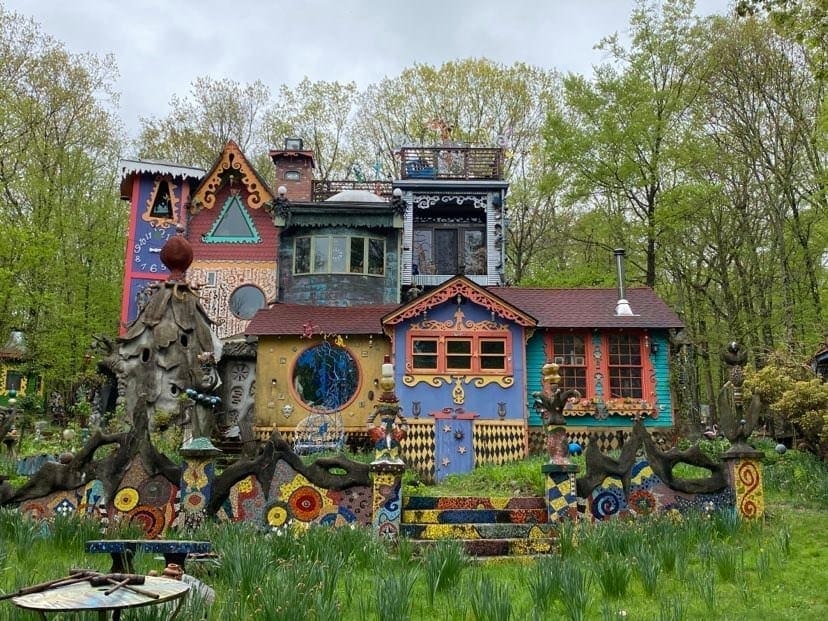
The front facade of Luna Parc / Photo by Jamie Corter
3. Why did you name the property Luna Parc? What was your inspiration?
When I bought this property, it was obviously the first place I’d ever owned, and I always thought that properties need to be named. So when I was thinking about what kind of name, there were a couple of funny ones. And then I remembered when I was in college, I spent my senior year at RISD in Rome, Italy. Outside the city limits of Rome, there’s an amusement park called Luna Parc—park with a “c.” I always remembered that my friends and I used to go there when we were in school, but I hadn’t really thought about it that much over the years. So when I was thinking about the concept of what this house could turn into, I was thinking, “Oh, an amusement park. An art theme park. Luna Parc.”
It wasn’t until years later that I even realized that the most famous amusement park in history was Luna Park in Coney Island. So I always make the distinction that my park has a “c.” It was sentimental, and it was Italian like my heritage.
4. Since starting the project in 1989, how has your art style changed or developed throughout the years?
I always cite my Italian heritage as where I really got my skills. I grew up in an artistic family, a family of craftsmen and artisans. My dad was amazing with materials. He could work with wood and cement. He was also a draftsman and a very good illustrator. I got a lot of my skill set from my dad by helping and observing him. On the Boscarino side, the Sicilians, many of them were carpenters and furniture makers. On my mom’s side, they were generally creative, kind of kooky thinkers, seamstresses, and amazing chefs. There was a lot of creativity in my household growing up.
When I bought this house, I had all the confidence in the world that I could really make this into something. Like I said, I had no idea what it was going to turn into. At 28 years old, you don’t have a grand perspective of your life and where it’s going. I was much more in the moment. I did come here buying this house with a pretty good skill set already and that youthful enthusiasm. Then over the years, my skills definitely got honed and I learned new materials. My craftsmanship got better. I’m 60 years old now and I’m glad to say that I’ve matured in some respects. Some of my friends would argue otherwise!
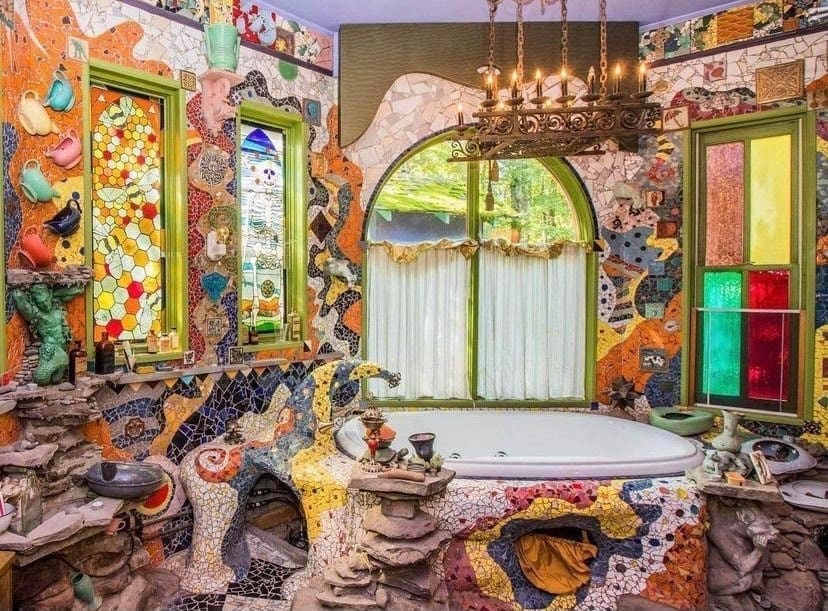
The mosaic work in Luna Parc’s bathroom is comprised of more than 1 million pieces of glass / Photo via @theresa_marie_photography
5. Throughout the property, you use common objects like bread tabs, bowling balls, crutches, and more to create engaging pieces of art. Where do your wacky ideas come from?
I honestly don’t know! If I could figure out where they come from and how to teach people to do it, I could probably be a millionaire. But I have to teach by example and this is one of my teachings: the creative process is just like academics and it’s just like athletics. It is a discipline that must be practiced every day; there is no question about it. If you were an athlete and you were training for any kind of sporting event, you’d have to be training every day.
The creative process is exactly the same; it’s a daily practice no matter what it is. There are certain days where I do more in a day, but there’s always something that I do creative-wise. That’s the way I approach it and that’s the way I like to explain it to young people who want to be artists but who don’t necessarily know how.
6. Following that question, what attracts you to these everyday items, and how do you go about incorporating them in a project? Do you think of a concept first or do you come across an interesting object and decide to make something with them?
It could be both ways. Sometimes I’ll see an object and I’ll just start collecting them. Not necessarily thinking that I have a piece in mind or a concept for the item. But for the bread tabs, I thought of doing like a giant mosaic; it’d probably have to go on the ceiling or something. Sometimes there’s an object that’s kind of appealing for whatever reason or maybe it’s the idea that I have and the idea materializes afterward.
Now for my current project, the telephone wall, I just have always loved telephones growing up in the ‘60s and ‘70s. That was the era of these really great designer telephones, so I’ve always collected telephones. I have so many that there’s probably like 50 or 60. I was thinking, “Well this has got to turn into something,” and this is probably the best solution.
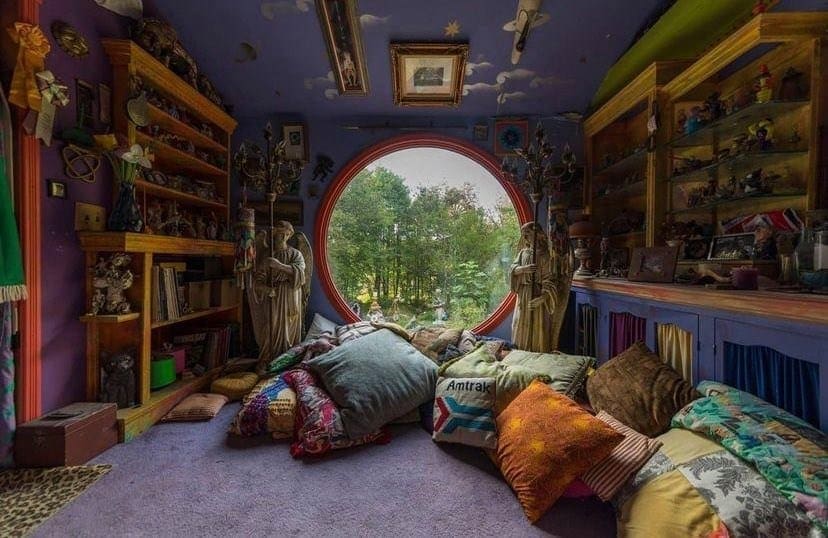
The comfy zen room overlooking the front of the property / Photo via @blackglassgallery
7. When you bought Luna Parc more than 30 years ago, the main house only had four rooms. Now, you’ve expanded to more than 15. Which is your favorite room in the house, or does it frequently change?
As far as the original house, I would say that the zen room is still my favorite. I made it a point to preserve the original little cottage and the zen room is in the front with the big round window. I actually rearranged the furniture, so it’s a little more conducive to sitting. It’s still very cozy down there. But in the new wing, my library is probably where I spend most of my time. It’s a very comforting space, especially in the morning because it’s dark. A lot of people feel like this is also their favorite room in the house.
8. Prior to the pandemic, you regularly traveled around the world. Personally, what’s your favorite place you’ve traveled to and why? What place has been the most influential to your artwork?
My most favorite place that I’ve ever been is Tibet. For me, it was like being on top of the world. Tibet was so magical, amazing, and beautiful; the culture was also so interesting. Most of my travels have been to Southeast Asia—Thailand, Cambodia, Lao, Vietnam, China, India, Nepal. All those countries. Then all over Europe, Morocco and Egypt.
Southeast Asia is the most influential as to what I include in artifacts. I’ve collected all kinds of textiles, religious articles, and personal affects from Asia. As far as my architecture, Asian architecture has shaped some of my vision, but I’m very Eurocentric. I would say that probably European architecture has been a little bit more profound for me.
But all my travels, wherever I’ve been, have definitely influenced my personal architecture that I build because I build it organically. I construct and translate the things that I’ve seen; then somehow, they get transformed in my brain and come out in certain ways, ways which I don’t really understand. I don’t question that—I just do it.
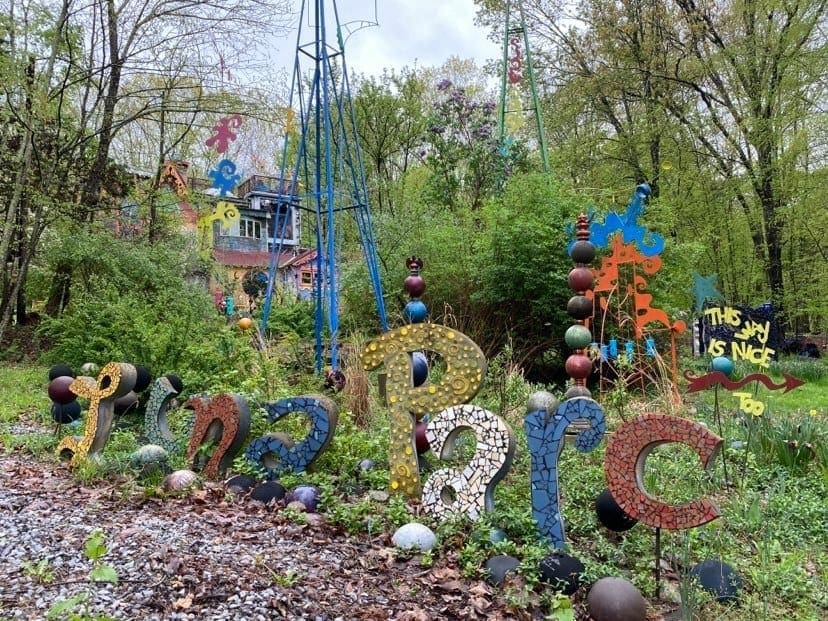
Welcome to Luna Parc / Photo by Jamie Corter
9. You’ve said that Luna Parc will continue to grow and evolve as long as you are alive. What does the future of Luna Parc look like?
So that’s tied into the Luna Parc Atelier Foundation, which is a non-profit. The mission of the foundation is art education, kind of as the broad subject, and then our focus group is later high school, gap year kids, and college students. We coach, we teach, and try to revive hand skills that are being lost.
The foundation is probably the most important thing for me right now. We started in 2015, so we’re in our sixth year. Whatever project is going on while they’re here is basically what their curriculum is. It could be tiling, it could be some kind of ceramic project, or it could be metalwork. We encourage them to do their own work as well; they can use all the facilities while they’re here. I usually vet students for their motivation and their enthusiasm. That’s really important. If someone is eager to learn, that’s the most important thing for me.
Ultimately, the foundation will inherit the house. That’s all put in place so that on my 95th birthday, I will sign over the deed to my house to the foundation. Hopefully, with my plan, there’s enough money to keep the project going and that the entire house is then safe. Whether it’s a private museum or an educational institution, I’m sure it will evolve somewhat when I’m gone.
Have you ever visited Luna Parc in Sandyston, NJ? If so, what was your favorite art installation? Tell us in the comments below!
Main image by Jamie Corter
About the Author/s
Jamie Corter is a 21-year-old aspiring journalist from Sparta, NJ. In her free time, she enjoys volunteering, discovering new TV shows, and spoiling her cat.
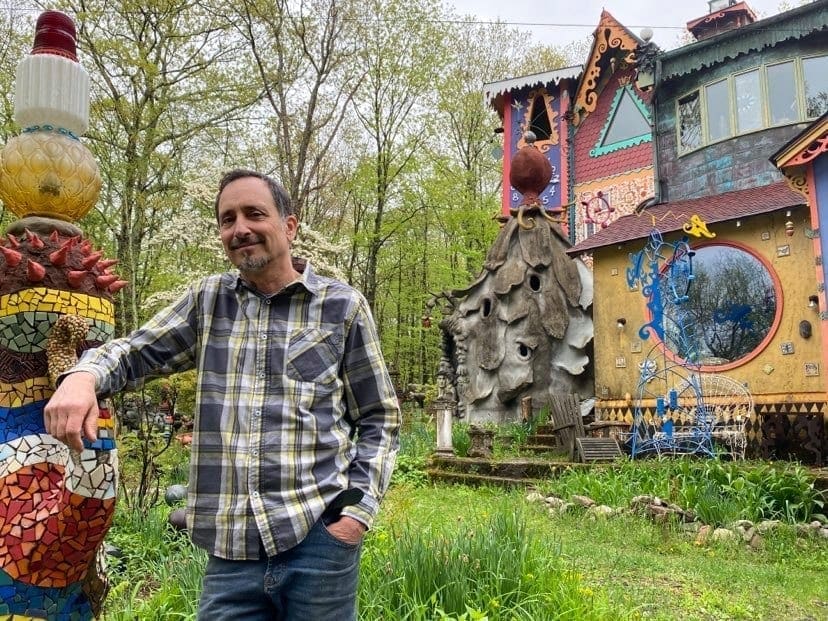
2 comments
I have been to Luna Parc many times. It is truly a magical place. Ricky’s energy envelopes you the moment you walk through the gates. His artistic world is mind boggling.
Your interview with Ricky is wonderful. You have a very bright future in journalism.
The shower is incredible, love the wine cork backsplash, and the chapel too. The blue glass igloo….so many amazing things how do you pick a fave? Can’t wait to visit again!